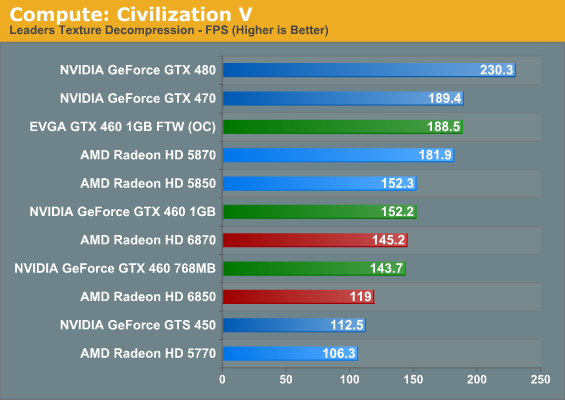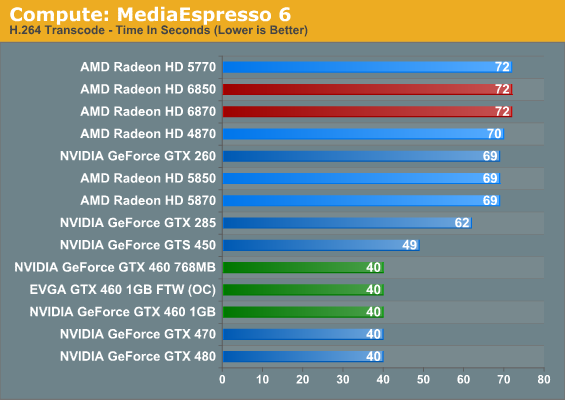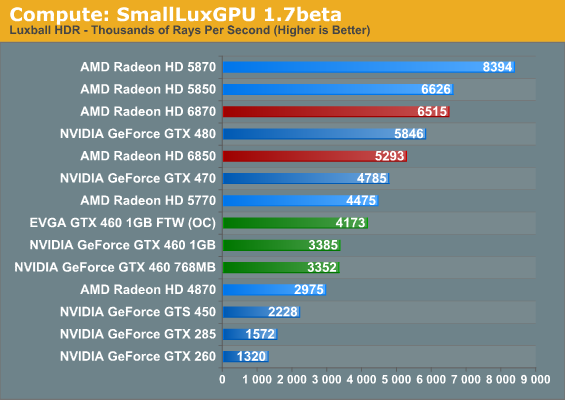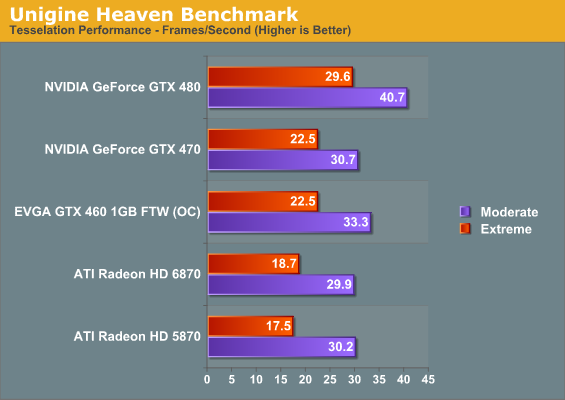AMD’s Radeon HD 6870 & 6850: Renewing Competition in the Mid-Range Market
by Ryan Smith on October 21, 2010 10:08 PM ESTFor a while now we’ve been trying to establish a proper cross-platform compute benchmark suite to add to our GPU articles. It’s not been entirely successful.
While GPUs have been compute capable in some form since 2006 with the launch of G80, and AMD significantly improved their compute capabilities in 2009 with Cypress, the software has been slow to catch on. From gatherings such as NVIDIA’s GTC we’ve seen first-hand how GPU computing is being used in the high-performance computing market, but the consumer side hasn’t materialized as quickly as the right situations for using GPU computing aren’t as straightforward and many developers are unwilling to attach themselves to a single platform in the process.
2009 saw the ratification of OpenCL 1.0 and the launch of DirectCompute, and while the launch of these cross-platform APIs removed some of the roadblocks, we heard as recently as last month from Adobe and others that there’s still work to be done before companies can confidently deploy GPU compute accelerated software. The immaturity of OpenCL drivers was cited as one cause, however there’s also the fact that a lot of computers simply don’t have a suitable compute-capable GPU – it’s Intel that’s the world’s biggest GPU vendor after all.
So here in the fall of 2010 our search for a wide variety of GPU compute applications hasn’t panned out quite like we expected it too. Widespread adoption of GPU computing in consumer applications is still around the corner, so for the time being we have to get creative.
With that in mind we’ve gone ahead and cooked up a new GPU compute benchmark suite based on the software available to us. On the consumer side we have the latest version of Cyberlink’s MediaEspresso video encoding suite and an interesting sub-benchmark from Civilization V. On the professional side we have SmallLuxGPU, an OpenCL based ray tracer. We don’t expect this to be the be all and end all of GPU computing benchmarks, but it gives us a place to start and allows us to cover both cross-platform APIs and NVIDIA & AMD’s platform-specific APIs.
Our first compute benchmark comes from Civilization V, which uses DirectCompute to decompress textures on the fly. Civ V includes a sub-benchmark that exclusively tests the speed of their texture decompression algorithm by repeatedly decompressing the textures required for one of the game’s leader scenes.

In our look at Civ V’s performance as a game, we noted that it favors NVIDIA’s GPUs at the moment, and this may be part of the reason why. NVIDIA’s GPUs clean up here, particularly when compared to the 6800 series and its reduced shader count. Furthermore within the GPU families the results are very straightforward, with the order following the relative compute power of each GPU. To be fair to AMD they made a conscious decision to not chase GPU computing performance with the 6800 series, but as a result it fares poorly here.
Our second compute benchmark is Cyberlink’s MediaEspresso 6, the latest version of their GPU-accelerated video encoding suite. MediaEspresso 6 doesn’t currently utilize a common API, and instead has codepaths for both AMD’s APP (née Stream) and NVIDIA’s CUDA APIs, which gives us a chance to test each API with a common program bridging them. As we’ll see this doesn’t necessarily mean that MediaEspresso behaves similarly on both AMD and NVIDIA GPUs, but for MediaEspresso users it is what it is.

We decided to go ahead and use MediaEspresso in this article not knowing what we’d find, and it turns out the results were both more and less than we were expecting at the same time. While our charts don’t show it, video transcoding isn’t all that GPU intensive with MediaEspresso; once we achieve a certain threshold of compute performance on a GPU – such as a GTX 460 in the case of an NVIDIA card – the rest of the process is CPU bottlenecked. As a result all of our Fermi NVIDIA cards at the GTX 460 or better take just as long to encode our sample video, and while the AMD cards show some stratification, it’s on the order of only a couple of seconds. From this it’s clear that with Cyberlink’s technology having a GPU is going to help, but it can’t completely offload what’s historically been a CPU-intensive activity.
As for an AMD/NVIDIA cross comparison, the results are straightforward but not particularly enlightening. It turns out that MediaEspresso 6 is significantly faster on NVIDIA GPUs than it is on AMD GPUs, but since we’ve already established that MediaEspresso 6 is CPU limited when using these powerful GPUs, it doesn’t say anything about the hardware. AMD and NVIDIA both provide common GPU video encoding frameworks for their products that Cyberlink taps in to, and it’s here where we believe the difference lies.
In particular we see MediaEspresso 6 achieve 50% CPU utilization (4 core) when being used with an NVIDIA GPU, while it only achieves 13% CPU utilization (1 core) with an AMD GPU. At this point it would appear that the CPU portions of NVIDIA’s GPU encoding framework are multithreaded while AMD’s framework is singlethreaded. And since the performance bottleneck for video encoding still lies with the CPU, this would be why the NVIDIA GPUs do so much better than the AMD GPUs in this benchmark.
Our final GPU compute benchmark is SmallLuxGPU, the GPU ray tracing branch of the open source LuxRender renderer. While it’s still in beta, SmallLuxGPU recently hit a milestone by implementing a complete ray tracing engine in OpenCL, allowing them to fully offload the process to the GPU. It’s this ray tracing engine we’re testing.

Compared to our other two GPU computing benchmarks, SmallLuxGPU follows the theoretical performance of our GPUs much more closely. As a result our Radeon GPUs with their difficult-to-utilize VLIW5 design end up topping the charts by a significant margin, while the fastest comparable NVIDIA GPU is still 10% slower than the 6850. Ultimately what we’re looking at is what amounts to the best-case scenarios for these GPUs, with this being as good an example as any that in the right circumstances AMD’s VLIW5 shader design can go toe-to-toe with NVIDIA’s compute-focused design and still win.
At the other end of the spectrum from GPU computing performance is GPU tessellation performance, used exclusively for graphical purposes. For the Radeon 6800 series, AMD enhanced their tessellation unit to offer better tessellation performance at lower tessellation factors. In order to analyze the performance of AMD’s enhanced tessellator, we’re using the Unigine Heaven benchmark and Microsoft’s DirectX 11 Detail Tessellation sample program to measure the tessellation performance of a few of our cards.

Since Heaven is a synthetic benchmark at the moment (the DX11 engine isn’t currently used in any games) we’re less concerned with performance relative to NVIDIA’s cards and more concerned with performance relative to the 5870. Compared to the 5870 the 6870 ends up being slightly slower when using moderate amounts of tessellation, while it pulls ahead when using extreme amounts of tessellation. Considering that the 6870 is around 7% slower in games than the 5870 this is actually quite an accomplishment for Barts, and one that we can easily trace back to AMD’s tessellator improvements.

Our second tessellation test is Microsoft’s DirectX 11 Detail Tessellation sample program, which is a much more straightforward test of tessellation performance. Here we’re simply looking at the framerate of the program at different tessellation levels, specifically level 7 (the default level) and level 11 (the maximum level). Here AMD’s tessellation improvements become even more apparent, with the 6870 handily beating the 5870. In fact our results are very close to AMD’s own internal results – at level 7 the 6870 is 43% faster than the 5870, while at level 11 that improvement drops to 29% as the increased level leads to an increasingly large tessellation factor. However this also highlights the fact that AMD’s tessellation performance still collapses at high factors compared to NVIDIA’s GPUs, making it all the more important for AMD to encourage developers to use more reasonable tessellation factors.










197 Comments
View All Comments
Ryan Smith - Friday, October 22, 2010 - link
In case it isn't obvious from the slipshod organization of the article, we didn't quite get it done on time. We had less than a week to put this article together when normally for an article of this size it takes 2 weeks. Check back in the morning, everything on Eyefinity, DP1.2, etc will be up by then.counter03 - Friday, October 22, 2010 - link
i am quite interested in that 'mst hub'.is there any available product now?well,i just find nothing with google.wolrah - Friday, October 22, 2010 - link
The card still has two TMDS clock generators. This means only two DVI/HDMI displays can be driven off the card at one time, no matter what connection. With that in mind, I wouldn't be surprised if the card doesn't even support passive adapters as there is literally no good reason to ever use them. You already have two native ports, so with a maximum of two DVI displays that's that.Regardless of if passive adapters are supported, you'll still need active adapters or native DisplayPort on your display to run three or four monitors off this card.
Supposedly it also supports DisplayPort daisy chaining, so possibly when monitors arrive that have an out port it may handle more than four displays, but again only a maximum of two can be DVI/HDMI without active adapters.
ninjaquick - Monday, October 25, 2010 - link
DP support shouldn't be a problem since I've seen quite a few monitors coming out with DP in and some with I/O.Abot13 - Saturday, October 23, 2010 - link
With the 6800 series the cards can support up to 6 monitors in Eyefinity. The DP ports can use a DP hub or the monitors can be chained with DP. Either way the max is 6 monitors per card.ol1bit - Thursday, October 21, 2010 - link
The naming stinks, but I can see how these cards will be a big Christmas season for AMD.So people that don't the new naming scheme will rush out an buy the bigger names. Smooth Marketing Move.
Well, if the 6900's launch next month, that will be fun to see.
Zokudu - Thursday, October 21, 2010 - link
You removed Left 4 Dead from your benchmarks. Does this mean you won't be replacing it with another Source game (ie L4D2 or maybe Portal 2 when that releases)?I know its not 100% perfect but 3 of the top 10 selling games on steam right now are run on the Source engine and the only other ones that share and engine are BF:BC2 and MoH both using Frostbite. I would think that having some form of a Source game in there would be a good idea considering the vast amount of popular games that run on it. I always used the L4D benchmark to compare performance for TF2 and CS:S. in the past.
Otherwise good review and I'm excited for the HD6900 launch next month.
Ryan Smith - Friday, October 22, 2010 - link
By the time Portal 2 comes out, it'll be about the time we refresh our suite anyhow. For the time being the existing Source games run on anything (even the GT 430 got L4D playable at 1680 with 4xAA) so it's not a useful benchmark, especially since there's no guarantee Portal will run that well.AmdInside - Thursday, October 21, 2010 - link
In the 3DTV Play article, you mentioned AMD's 6000 series would challenge NVIDIA in 3D with the 6000 series but I didn't read any info on it in this article. What gives?StevoLincolnite - Friday, October 22, 2010 - link
Also didn't see any mention of the improved crossfire performance either...